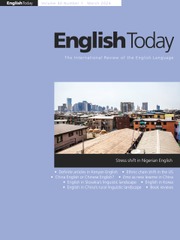No CrossRef data available.
Article contents
Abstract
An account of how grammar is being marginalized in the American university English curriculum.
- Type
- Research Article
- Information
- Copyright
- Copyright © Cambridge University Press 1999
References
Battenburg, John. 1995. “Linguistics in the English Department: Irreconcilable Differences?” In English Today 11.3 (07): 40–43.CrossRefGoogle Scholar
Braddock, Richard, Lloyd-Jones, Richard & Schoer, Lowell. 1963. Research in Written Composition. Champaign, IL: NCTE.Google Scholar
Brosnahan, Irene, & Neuleib, Janice. "Teaching Grammar Affectively: Learning to Like Grammar." In The Place of Grammar in Writing Instruction, Susan, Hunter & Ray, Wallace, eds. 204–212.Google Scholar
Buck, R. A. 1998. “Grammar and Critical Thinking.” In California English 3.3 (Spring): 14–16.Google Scholar
Cameron, Deborah. 1997. “Sparing the Rod: What Teachers Need to Know about Grammar.” In Changing English 4.2 (10): 229–239.CrossRefGoogle Scholar
Hillocks, George Jr., 1986. Research on Written Composition. Urbana, IL: National Council on Research in English.Google Scholar
Hunter, Susan & Wallace, Ray, eds. 1995. The Place of Grammar in Writing Instruction. Portsmouth, NH: Boynton/Cook.Google Scholar
Kolln, Martha. 1981. “Closing the Books on Alchemy.” In College Composition and Communication 32: 139–51.CrossRefGoogle Scholar
Kolln, Martha & Funk, Robert. 1998. Understanding English Grammar. 5th edn.Boston: Allyn & Bacon.Google Scholar
Long, Steven H. 1996. “Why Johnny (or Joanne) Can't Parse.” In American Journal of Speech-Language Pathology 5.2 (05): 35–42.CrossRefGoogle Scholar


